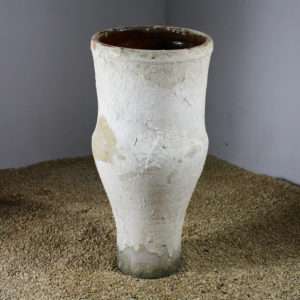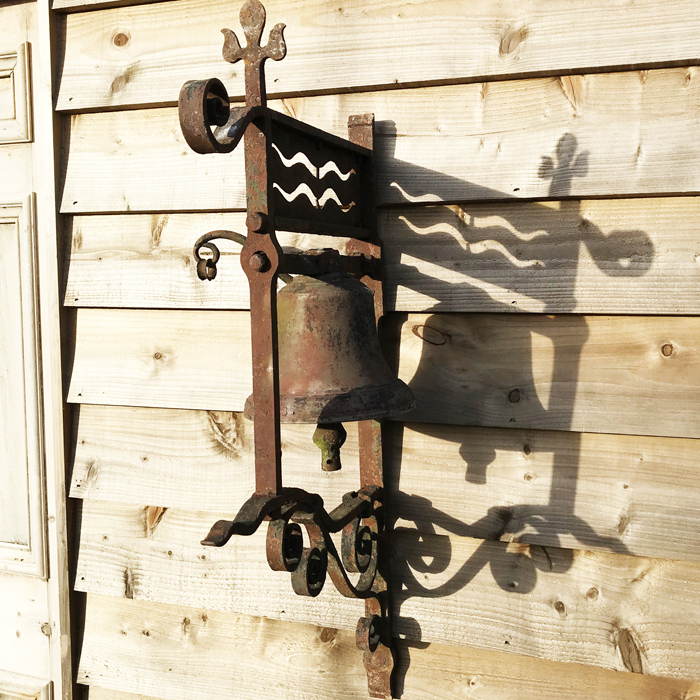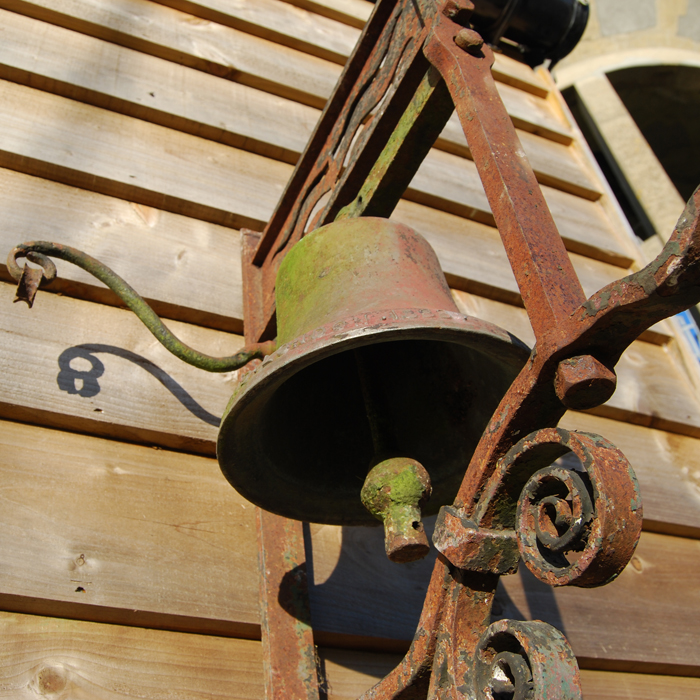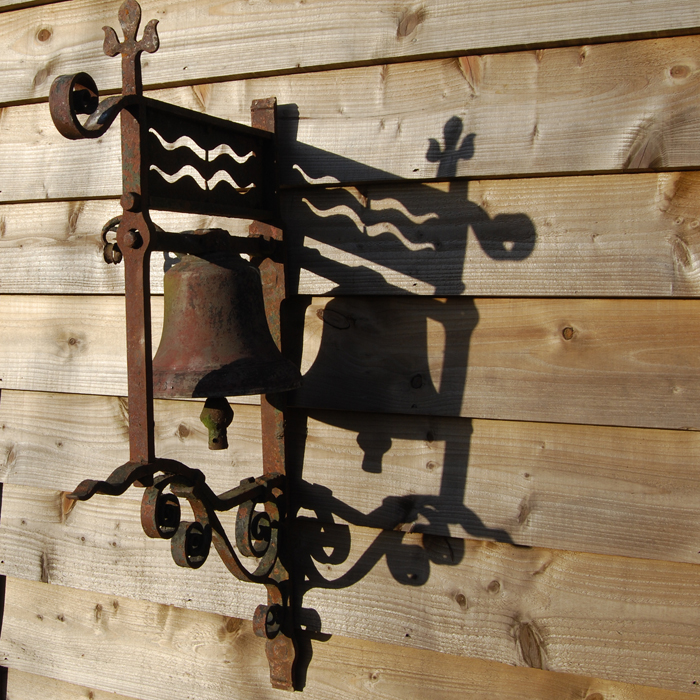A Victorian school bell,
by J Warner & Sons of London c.1888, suspended on a wrought-iron wall-bracket,
Archived Stock - This item is no longer available
A Victorian school bell,
the bell, cast in bell-metal bronze and bearing the maker's mark and date to the rim, with original clapper, suspended from a rotating rod with scrolled lever-arm, the bracket with a frieze pierced with wavy ornament and scroll work supports surmounted with a fleur-de-lys finial,
SOLD OUT
In stock
| Dimensions: | 107cm (42¼") High, 60cm (23½") Wide, the bracket (the bell: 22cm high, 27cm diameter) |
| Stock code: | 44320 |
| Categories: | |
| Location: |
John Warner & Sons, was one of the most celebrated bell foundries and is best known for casting Big Ben - the original Big Ben, not the second Big Ben that the Whitechapel foundry went on to cast!
Warner's operated at various locations in London from before 1782 until about 1924. These locations included Cheapside, Cripplegate (2 Jewin Crescent, commonly known as the Crescent Foundry), Spitalfields (Spelman Street) and Fleet Street. Warner kept the Jewin Crescent address as their registered office after the Spitalfields location was developed in the 1870s. Other Warner foundries or works were located at Tendring, Essex and at Stockton-on-Tees, where the original Big Ben was cast.
The story of the first Big Ben is here taken from the Stockton-on-Tees website - and is worth the re-telling as, over time, The Whitechapel Foundry - recently closed after a 900year run - has taken much of the limelight:
"The casting of the original bell was started on 6 August 1856 in John Warner‘s Foundry in Norton, Stockton on Tees. The gigantic mould had taken the previous six weeks to prepare and two special furnaces had been built to melt the 18 tons of molten metal required to make the bell which was to weigh almost 16 tons when completed.
The external height of the bell was 7 feet 10 inches with a diameter of 9 feet 5 inches. It was raised from the mould on 22 August 1856 and struck for the first time with a clapper weighing 7cwt. – it was considered to have a very fine tone indeed. There was an inscription around the bell that read ‘ Cast in the 20th year of the reign of her Majesty Queen Victoria, and in the year of our Lord 1856, from the design of Edmund Beckett Denison, Q.C.; Sir Benjamin Hall, Baronet, M.P., Chief Commissioner of Works.’ In the middle of the bell are the Royal coat of arms, and the name of the makers “John Warner and Sons, Crescent Foundry, Cripplegate, London.” ( this was the Head Office of the Norton Foundry).
The bell was transported to Hartlepool by rail which required a bit of planning as the bell was so wide that no other rail traffic could pass it on its journey. From Hartlepool it went by sea to the port of London where it was loaded onto a low carriage and a team of sixteen horses hauled it to the Palace of Westminster.
The tower was not completed at this time so the bell was suspended on a gantry in the Palace Yard at Westminster for trials. These were necessary to determine the optimum weight of the clapper, the ideal angle of the clapper arm and the best point of impact.
It was traditional to give large bells a name before they were rung. It was decided to christen the great bell Big Ben in honour of Sir Benjamin Hall who was President of the Board of Works during the casting of the bell.
Popular myth has it that the bell shattered the first time it was struck but the reality is that it was many months after the trials began, in October 1857, that it cracked. At the time it had become customary to toll the bell at 1pm on Saturdays and it was on one of these occasions that a change of tone was noticed in the bell. Investigations showed that the bell had developed a large crack directly opposite the point of impact of the clapper.
While arguments raged over who was responsible for the faulted bell it was generally accepted that the damage was due to the fact that the clapper being experimented with was far too heavy for the bell itself.
It wasn’t until February of the following year that the Norton bell was taken down from the gantry it was being tested on and broken up. This was achieved by laying the bell on its side and then dropping a ‘wrecking ball’ weighing 24 cwt onto it. This was repeated until the bell was reduced to manageable fragments. The job of recasting the bell was offered to Warners of Norton but the price they quoted was deemed too high so the job was given to the Whitechapel Foundry of George Mears.
The remnants of the original bell were carted to the Whitechapel Bell Foundry for recasting. The patterns for the new bell were approved in November of 1858. The preparation of the mould was started in December 1858 and took more than three months to complete. The casting of the new bell was carried out in April of 1859, still known as Big Ben it weighed 2 tons less than the original.
In May 1859 the bell was transported to Westminster where it was hoisted onto the same gantry used to test the original. This time the testing was more successful and the bell was finally hoisted up the bell tower in July of 1859.
The new bell rang out successfully for about two months when again a small crack appeared on the rim. This time it was out of action for about three years while a solution to the problem could be found. This involved chipping a small section of the bell away around the crack to prevent it spreading and rotating the bell slightly so that the clapper struck it at a different point. This gives us the sound we hear today."
Warner's of Norton also cast the largest of the four ‘quarter’ bells that they struck after the completion of the original Big Ben. "It weighs more than four tons and has a diameter of more than six feet. It was this bell that was used as a substitute for Big Ben itself during the three years it was out of commission.".
Big Ben has again fallen silent during ongoing restoration works at Elizabeth Tower - if you miss its tolls, your chance to ring a Warner to your own time is available here.
You may also be interested in these items
Recently Viewed Items
-

A large North African terracotta storage jar,
Stock code: 44937A large North African terracotta storage jar,
the tapering pot with a limed exterior and part-glazed interior,Dimensions: 71cm (28") High, 34cm (13½") WideStock code: 44937 -

Contemporary Hundi lanterns
£875 each Stock code: 79690Contemporary Hundi lanterns
with three light suspended fitting.Dimensions: 48cm (19") High, 28cm (11") Wide, 26.5cm (10½") in DiameterStock code: 79690£875 each



